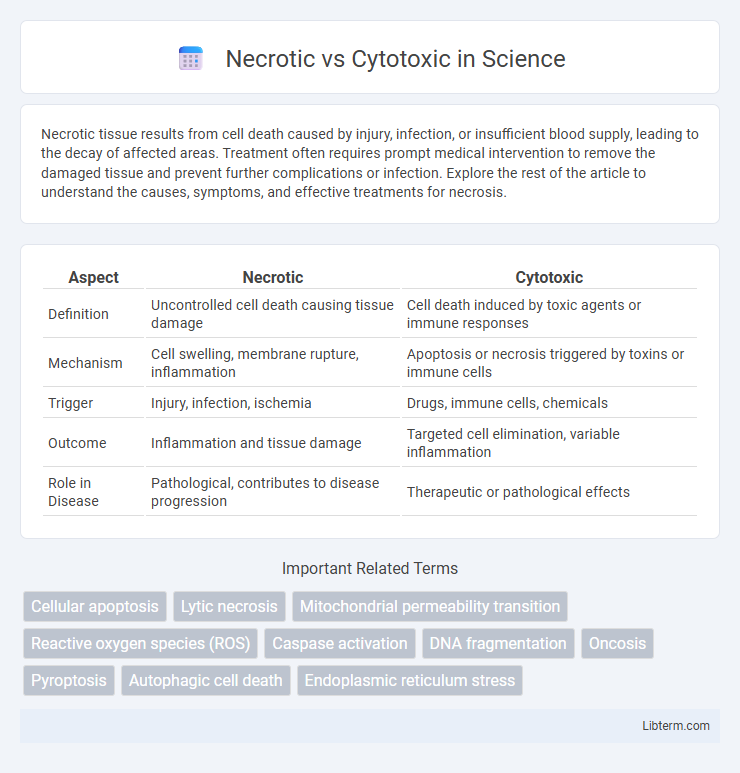Necrotic tissue results from cell death caused by injury, infection, or insufficient blood supply, leading to the decay of affected areas. Treatment often requires prompt medical intervention to remove the damaged tissue and prevent further complications or infection. Explore the rest of the article to understand the causes, symptoms, and effective treatments for necrosis.
Table of Comparison
| Aspect | Necrotic | Cytotoxic |
|---|---|---|
| Definition | Uncontrolled cell death causing tissue damage | Cell death induced by toxic agents or immune responses |
| Mechanism | Cell swelling, membrane rupture, inflammation | Apoptosis or necrosis triggered by toxins or immune cells |
| Trigger | Injury, infection, ischemia | Drugs, immune cells, chemicals |
| Outcome | Inflammation and tissue damage | Targeted cell elimination, variable inflammation |
| Role in Disease | Pathological, contributes to disease progression | Therapeutic or pathological effects |
Understanding Cell Death: Necrosis vs Cytotoxicity
Necrosis is a form of uncontrolled cell death characterized by cell membrane rupture and inflammation, often resulting from external injury or trauma. Cytotoxicity, on the other hand, refers to the ability of certain substances or immune cells to induce targeted cell damage or death, typically through apoptosis or programmed cell death pathways. Understanding the distinctions between necrosis and cytotoxicity is crucial for developing therapeutic strategies in diseases such as cancer, where controlled cell death mechanisms can be harnessed for treatment.
Mechanisms of Necrotic Cell Death
Necrotic cell death is characterized by the loss of membrane integrity, resulting in uncontrolled release of cellular contents and inflammation. The primary mechanisms involve ATP depletion, reactive oxygen species (ROS) accumulation, mitochondrial dysfunction, and calcium overload, which trigger cellular swelling and membrane rupture. Unlike cytotoxicity that targets specific cell components to induce apoptosis, necrosis causes direct physical damage leading to cell lysis and tissue injury.
How Cytotoxicity Causes Cellular Damage
Cytotoxicity causes cellular damage by disrupting essential cellular functions through the release of reactive oxygen species, interfering with mitochondrial activity, and triggering apoptosis or programmed cell death pathways. Unlike necrotic damage, which results from uncontrolled cell death and leads to inflammation, cytotoxic effects are often targeted and mediated by specific toxins, drugs, or immune responses at the molecular level. Understanding the mechanisms of cytotoxicity is crucial in fields such as pharmacology and toxicology for developing therapies that minimize unintended cellular injury.
Key Differences Between Necrotic and Cytotoxic Processes
Necrotic processes involve uncontrolled cell death resulting from external injury, leading to cellular swelling and membrane rupture that triggers inflammation. Cytotoxicity refers to the ability of certain substances or immune cells to specifically induce targeted cell death, often through apoptotic mechanisms that maintain membrane integrity. Key differences include necrosis causing passive, unregulated damage with inflammation, while cytotoxicity is a regulated, active process aimed at eliminating harmful or diseased cells.
Common Triggers for Necrosis in Human Cells
Common triggers for necrosis in human cells include physical trauma, ischemia, infection, and exposure to toxins or chemicals. These factors cause severe cellular damage, leading to loss of membrane integrity and uncontrolled cell death. Unlike cytotoxic processes driven by programmed pathways, necrosis results from acute injury and often triggers inflammatory responses.
Cytotoxic Agents: Types and Effects
Cytotoxic agents include alkylating agents, antimetabolites, mitotic inhibitors, and topoisomerase inhibitors, each targeting cellular components to induce cell death. These agents disrupt DNA replication, inhibit mitosis, or interfere with enzymatic processes essential for cancer cell proliferation. Their effects range from inducing apoptosis in malignant cells to causing side effects like myelosuppression and mucositis due to toxicity in healthy tissues.
Clinical Manifestations: Necrotic vs Cytotoxic Injuries
Necrotic injuries clinically manifest as localized tissue death with symptoms including severe pain, swelling, and loss of function, often accompanied by inflammation and potential secondary infection. Cytotoxic injuries primarily present with cellular swelling and impaired membrane function, leading to reversible cell injury initially, but may progress to cell death if the insult persists. Differentiating these injuries depends on the extent of cellular damage, where necrosis results in irreversible tissue destruction, contrasting with the potentially salvageable damage seen in cytotoxic insult.
Diagnostic Markers for Necrotic and Cytotoxic Damage
Diagnostic markers for necrotic damage include elevated levels of lactate dehydrogenase (LDH), creatine kinase (CK), and high-mobility group box 1 protein (HMGB1), which indicate cell membrane rupture and uncontrolled cell death. Cytotoxic damage is primarily identified through markers such as caspase activation, annexin V binding, and cytochrome c release, reflecting programmed cell death or apoptosis. Measurement of these specific biomarkers aids in differentiating necrosis from cytotoxicity in clinical and research settings.
Therapeutic Implications: Targeting Necrosis and Cytotoxicity
Targeting necrotic and cytotoxic pathways holds significant therapeutic potential in treating diseases characterized by cell death dysregulation. Modulating necrosis can reduce inflammatory damage in conditions like ischemic injury and neurodegeneration, while controlling cytotoxicity is crucial for minimizing adverse effects during cancer chemotherapy. Novel therapies aim to selectively inhibit necrotic signaling molecules such as RIPK1 and MLKL or enhance cytotoxic immune responses to improve treatment specificity and efficacy.
Future Perspectives in Research on Necrotic and Cytotoxic Cell Death
Future research on necrotic and cytotoxic cell death aims to elucidate distinct molecular pathways and identify novel biomarkers for targeted therapies. Advancements in high-throughput sequencing and single-cell analysis are expected to deepen understanding of cell death mechanisms and their differential roles in diseases such as cancer and neurodegeneration. Emerging therapeutic strategies focus on modulating necrosis and cytotoxicity to enhance treatment efficacy and minimize off-target effects.
Necrotic Infographic

 libterm.com
libterm.com